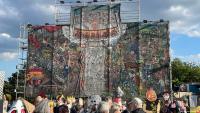 As agitprop, People’s Justice isn’t complex. On the right are the simple citizens, villagers and workers: victims of the regime. On the left are the accused perpetrators and their international accomplices. Representatives of foreign intelligence services – the Australian ASIO, MI5, the CIA – are depicted as dogs, pigs, skeletons and rats. There is even a figure labelled ‘007’. An armed column marches over a pile of skulls, a mass grave. Among the perpetrators is a pig-faced soldier wearing a Star of David and a helmet with ‘Mossad’ written on it. In the background stands a man with sidelocks, a crooked nose, bloodshot eyes and fangs for teeth. He is dressed in a suit, chewing on a cigar and wearing a hat marked ‘SS’: an Orthodox Jew, represented as a rich banker, on trial for war crimes – in Germany, in 2022.
As agitprop, People’s Justice isn’t complex. On the right are the simple citizens, villagers and workers: victims of the regime. On the left are the accused perpetrators and their international accomplices. Representatives of foreign intelligence services – the Australian ASIO, MI5, the CIA – are depicted as dogs, pigs, skeletons and rats. There is even a figure labelled ‘007’. An armed column marches over a pile of skulls, a mass grave. Among the perpetrators is a pig-faced soldier wearing a Star of David and a helmet with ‘Mossad’ written on it. In the background stands a man with sidelocks, a crooked nose, bloodshot eyes and fangs for teeth. He is dressed in a suit, chewing on a cigar and wearing a hat marked ‘SS’: an Orthodox Jew, represented as a rich banker, on trial for war crimes – in Germany, in 2022.
To read
10.08.2022 | by Eyal Weizman